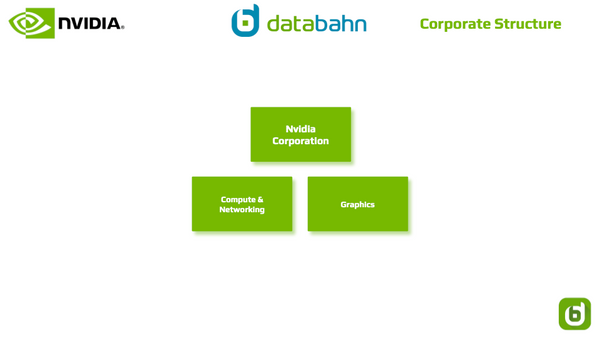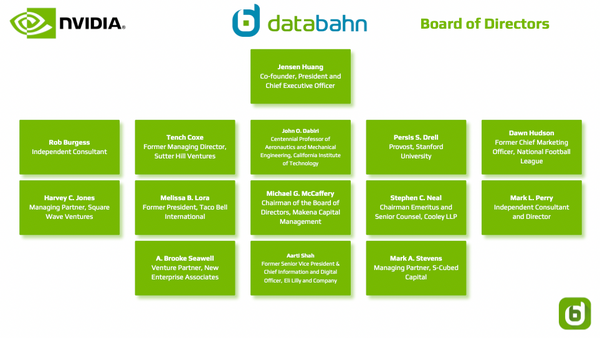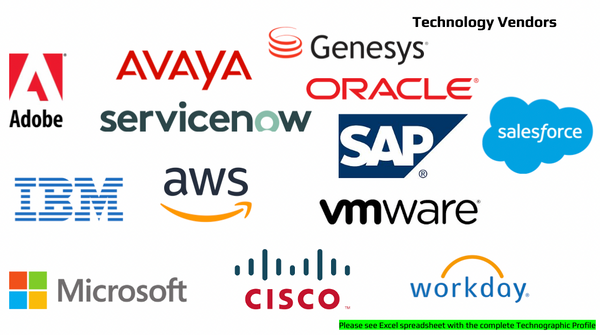NVIDIA org chart & sales intelligence blog
NVIDIA org chart & sales intelligence blog

NVIDIA Corporation
2788 San Tomas Expressway
Santa Clara, CA 95051
United States
Main Phone: (408) 486-2000
Website: https://www.NVIDIA.com
Industry Sector: Technology - Semiconductors
Full Time Employees: 26,196
Annual Revenues: $32.68 Billion (2022)
CEO: Jen-Hsun Huang, Co-Founder, CEO, President & Director
Fortune 500 Rank: #152 in 2023
NVIDIA Highlights
- NVIDIA were ranked #152 on the Fortune 500 with $27 Billion in annual revenues last year ($15B in Compute & Networking and $12B in Graphics).
- NVIDIA's core growth strategies revolve around several key areas; Advancing Accelerated Computing, Leadership in AI, Excellence in Computer Graphics, Autonomous Vehicles (AV) and their Intellectual Property.
- They've emerged from a tough 2022 due to supply chain shortages, economic headwinds, and geopolitical tensions. In 2023, they led the global rally rising as high as over 196 per cent in the first six months after artificial intelligence (AI) took center-stage this year.
- NVIDIA have invested more than $37 billion in R&D since their inception.
- NVIDIA is partnering with Azure, GCP and Oracle Cloud to bring NVIDIA AI to every company from a browser.
- NVIDIA help millions of developers across industries solve complex problems. The NVIDIA core platforms include NVIDIA RTX for graphics, NVIDIA HPC for scientific computing, NVIDIA AI for data science and artificial intelligence, NVIDIA DRIVE for autonomous vehicles, and NVIDIA Omniverse for industrial digitalization applications.
- NVIDIA Clara is being used by more than 100 healthcare partners to tap into a $2 Trillion market.
What are NVIDIA's growth strategies in 2023?
NVIDIA's core strategies revolve around several key areas:Advancing Accelerated Computing: NVIDIA focuses on enhancing its accelerated computing platform, which offers superior performance and energy efficiency. The company leverages innovation across multiple layers, including architecture, chip design, system, interconnect, and software, delivering substantial performance advantages in various markets like Data Center, Gaming, Professional Visualization, and Automotive.
Leadership in AI: NVIDIA aims to maintain its leadership position in artificial intelligence (AI) by providing a comprehensive accelerated computing platform for deep learning and machine learning, covering training and inferencing. They continue to develop AI-specific features in their GPU architecture and foster a large ecosystem of developers, universities, startups, and partnerships to promote AI technology adoption.
Excellence in Computer Graphics: NVIDIA believes computer graphics is integral to the evolution of computing. They invest in research and development to enhance user experiences in entertainment, professional visualization, virtual worlds, and simulations. Their technologies power gaming, creative applications, and cloud-based interactive graphics across various devices.
Autonomous Vehicles (AV): NVIDIA sees the potential for AI-driven autonomous vehicles to revolutionize transportation. They offer a comprehensive, functionally safe AI-based hardware and software solution under the DRIVE brand, collaborating with automotive OEMs, tier-1 suppliers, and startups to drive the adoption of autonomous driving technologies.
Intellectual Property (IP): NVIDIA recognizes the value of its intellectual property and offers licenses and development agreements to customers and partners, allowing them to incorporate NVIDIA's technology into their products. These arrangements extend the reach of NVIDIA's IP across industries and applications.
How would you describe the NVIDIA business?
NVIDIA is a global technology company that specializes in artificial intelligence (AI), computer graphics, and high-performance computing. The company designs and manufactures a variety of products, including graphics processing units (GPUs), system-on-a-chips (SoCs), and software.
NVIDIA's GPUs are used in a wide range of applications, including gaming, data centers, artificial intelligence, and self-driving cars. The company's SoCs are used in a variety of devices, including smartphones, tablets, and wearables. NVIDIA's software is used to develop and deploy AI applications.
NVIDIA is a leading player in the AI market. The company's GPUs are used to power AI applications in a variety of industries, including healthcare, finance, and manufacturing. NVIDIA is also a leader in the data center market. The company's GPUs are used in data centers to accelerate a variety of workloads, including machine learning, deep learning, and high-performance computing.
NVIDIA is a well-respected company with a strong track record of innovation. The company has a large and loyal customer base, and it is well-positioned to continue to grow in the years to come.
Here are some of the key business drivers for NVIDIA:
- The growth of the AI market
- The increasing demand for high-performance computing
- The adoption of cloud computing
- The development of self-driving cars
- The growth of the gaming market
NVIDIA is well-positioned to benefit from these trends. The company has a strong portfolio of products and solutions that address the needs of these markets. NVIDIA is also a leader in innovation, and it is constantly developing new products and technologies to meet the needs of its customers.
How would you describe the NVIDIA organizational structure?
NVIDIA employs a unique organizational framework, blending functional and matrix structures to optimize its operations. The corporation is structured into functional departments, encompassing critical areas like engineering, marketing, and sales. Alongside these, it operates temporary project teams assembled for precise initiatives.
The functional departments play a pivotal role in nurturing and enhancing NVIDIA's core competencies. For instance, the engineering department spearheads the design and development of NVIDIA's product portfolio, while the marketing department actively champions product promotion and sales.
Project teams, on the other hand, are tasked with tackling specific missions, such as creating innovative products or venturing into new markets. These teams comprise individuals from diverse functional backgrounds, enabling NVIDIA to harness a wide spectrum of expertise to address intricate challenges.
This hybrid arrangement empowers NVIDIA with the efficiency of functional departments, offering a structured resource framework, while also facilitating swift responses to market dynamics through adaptable project teams.
For a more comprehensive view of NVIDIA's organizational structure, let's delve into its various tiers:
- Board of Directors: NVIDIA's board of directors exercises comprehensive oversight over the corporation. Comprising independent directors with no NVIDIA employment ties, this body ensures robust governance.
- Executive Team: Steering the day-to-day operations, the executive team, under the leadership of the CEO, includes other senior executives, steering the company's strategic vision.
- Functional Departments: Critical to the maintenance of NVIDIA's core competencies, these departments span engineering, marketing, sales, finance, and human resources, all working cohesively to drive excellence.
- Project Teams: Focused on targeted missions, project teams often comprise cross-functional personnel, leveraging varied expertise to tackle specific challenges.
NVIDIA has meticulously designed its organizational structure to facilitate the realization of its ambitions as a premier provider of accelerated computing solutions. This structure ingeniously combines efficiency and flexibility, vital attributes in a rapidly evolving industry landscape.
Who are the top executives on the NVIDIA org chart?
| NAME | TITLE | COMPANY | PHONE | |
| Jensen Huang | Founder, President, and CEO | NVIDIA | (408) 486 2000 | [f][last]@NVIDIA.com |
| Colette Kress | EVP and Chief Financial Officer | NVIDIA | (408) 486 2000 | [f][last]@NVIDIA.com |
| Debora Shoquist | EVP, Operations | NVIDIA | (408) 486 2000 | [f][last]@NVIDIA.com |
| Jay Puri | EVP, Worldwide Field Operations | NVIDIA | (408) 486 2000 | [f][last]@NVIDIA.com |
| Chris A. Malachowsky | Founder and NVIDIA Fellow | NVIDIA | (408) 486 2000 | [f][last]@NVIDIA.com |
| Tim Teter | SVP, General Counsel and Secretary | NVIDIA | (408) 486 2000 | [f][last]@NVIDIA.com |
Who are the Board of Directors on the NVIDIA org chart?
| NAME | TITLE | DESCRIPTION | COMPANY | PHONE | |
| Stephen C. Neal | Board Member | Chairman Emeritus and Senior Counsel, Cooley LLP | NVIDIA | (408) 486 2000 | [f][last]@NVIDIA.com |
| Michael G. McCaffery | Board Member | Chairman of the Board of Directors, Makena Capital Management | NVIDIA | (408) 486 2000 | [f][last]@NVIDIA.com |
| Jensen Huang | Board Member | Co-founder, President and Chief Executive Officer | NVIDIA | (408) 486 2000 | [f][last]@NVIDIA.com |
| Dawn Hudson | Board Member | Former Chief Marketing Officer, National Football League | NVIDIA | (408) 486 2000 | [f][last]@NVIDIA.com |
| Tench Coxe | Board Member | Former Managing Director, Sutter Hill Ventures | NVIDIA | (408) 486 2000 | [f][last]@NVIDIA.com |
| Melissa B. Lora | Board Member | Former President, Taco Bell International | NVIDIA | (408) 486 2000 | [f][last]@NVIDIA.com |
| Aarti Shah | Board Member | Former Senior Vice President & Chief Information and Digital Officer, Eli Lilly and Company | NVIDIA | (408) 486 2000 | [f][last]@NVIDIA.com |
| Rob Burgess | Board Member | Independent Consultant | NVIDIA | (408) 486 2000 | [f][last]@NVIDIA.com |
| Mark L. Perry | Board Member | Independent Consultant and Director | NVIDIA | (408) 486 2000 | [f][last]@NVIDIA.com |
| Mark A. Stevens | Board Member | Managing Partner, S-Cubed Capital | NVIDIA | (408) 486 2000 | [f][last]@NVIDIA.com |
| Harvey C. Jones | Board Member | Managing Partner, Square Wave Ventures | NVIDIA | (408) 486 2000 | [f][last]@NVIDIA.com |
| Persis S. Drell | Board Member | Provost, Stanford University | NVIDIA | (408) 486 2000 | [f][last]@NVIDIA.com |
| A. Brooke Seawell | Board Member | Venture Partner, New Enterprise Associates | NVIDIA | (408) 486 2000 | [f][last]@NVIDIA.com |
| John O. Dabiri | Board Member | Centennial Professor of Aeronautics and Mechanical Engineering, California Institute of Technology | NVIDIA | (408) 486 2000 | [f][last]@NVIDIA.com |
What is NVIDIA doing to improve its data centers?

NVIDIA is actively working on ensuring the optimal health of its data centers, adopting an innovative approach. The company has recently submitted a patent application for a cutting-edge "health monitoring" system, specifically designed to enhance the security of data centers. Although the patent encompasses a broad range of applications, at its core, NVIDIA's system conducts diagnostic assessments on various components within data centers. It utilizes an AI model to scrutinize data that would typically remain confined within the facility due to its sensitive nature.
NVIDIA acknowledged that some data centers operate under strict data access constraints, preventing the transmission of log information beyond their secure perimeters. This situation can hinder the acquisition of essential diagnostic support, potentially impeding the overall lifecycle monitoring process.
In traditional setups, data center operators would forward log data to dedicated diagnostics and debugging teams to identify issues and formulate solutions. However, in secure data centers, the information cannot leave the premises, which presents challenges when debugging issues due to the lack of comprehensive data.
NVIDIA's novel system takes a different approach. Instead of transmitting log data outside the data center for analysis, it employs a model that is initially introduced into the data center environment. Log data is collected on-site within the secure facility. Subsequently, the system transmits both the model and the locally gathered data out of the data center. Notably, this transmission employs homomorphic encryption, a secure technique that allows an AI model to utilize the data without the need for decryption.
Which companies is NVIDIA investing in?

NVIDIA has recently joined the ranks of investors in Databricks, marking a significant development as the chipmaker continues its investment spree in various AI infrastructure startups. Notably, NVIDIA has backed several prominent companies like Hugging Face, Cohere, and CoreWeave, all of which have reached multibillion-dollar valuations.
Ali Ghodsi, the CEO of Databricks, revealed that discussions with NVIDIA CEO Jensen Huang began some time ago, underscoring the growing importance of a strategic collaboration as both companies delve deeper into the realm of AI. Databricks has been a significant consumer of NVIDIA's graphics processing units (GPUs), primarily leveraging them through various public cloud platforms. This collaboration has intensified further following Databricks' acquisition of Mosaic. Ghodsi also disclosed that NVIDIA and Mosaic had been exploring partnership possibilities even before the acquisition.
Ghodsi emphasized the natural synergy between the two companies, stating, "It made sense to partner more closely. At its core, we operate in complementary markets."
How are Google and NVIDIA expanding their partnership?

Google Cloud Next - Google Cloud and NVIDIA have unveiled groundbreaking AI infrastructure and software solutions, empowering customers to create and deploy large-scale generative AI models and accelerate data science workloads.
During a candid conversation at Google Cloud Next, Google Cloud CEO Thomas Kurian and NVIDIA's founder and CEO, Jensen Huang, discussed how their partnership is revolutionizing machine learning services for some of the world's most prominent AI users. This collaboration simplifies the deployment of AI supercomputers through Google Cloud offerings, which are intricately built upon NVIDIA technologies. These newly introduced hardware and software integrations harness the same NVIDIA technologies that have driven innovation within Google DeepMind and Google's research teams over the past two years.
Huang emphasized the significance of this collaboration, stating, "We are witnessing a pivotal moment where accelerated computing and generative AI are converging to fuel innovation at an unprecedented rate. Our expanded partnership with Google Cloud will empower developers with infrastructure, software, and services that not only enhance energy efficiency but also reduce costs."
Kurian added, "Google Cloud has a rich history of AI innovation, aiming to foster and expedite innovation for our valued customers. Many of Google's products rely on NVIDIA GPUs, and numerous customers are seeking NVIDIA accelerated computing to facilitate efficient development of Large Language Models (LLMs) for advancing generative AI."
Google's framework for constructing extensive Large Language Models (LLMs), known as PaxML, has been optimized for NVIDIA accelerated computing. Originally designed to span multiple Google TPU accelerator slices, PaxML now enables developers to harness the capabilities of NVIDIA H100 and A100 Tensor Core GPUs for advanced, fully customizable experimentation and scalability. A GPU-optimized PaxML container is readily available through the NVIDIA NGC™ software catalog. Furthermore, PaxML operates on JAX, which has been finely tuned for GPUs with the assistance of the OpenXLA compiler.
Leading the way, Google DeepMind and other Google researchers have already adopted PaxML in conjunction with NVIDIA GPUs for their pioneering research endeavors.
The NVIDIA-optimized PaxML container is now accessible on the NVIDIA NGC container registry, catering to researchers, startups, and enterprises worldwide that are forging the next generation of AI-driven applications.
What do the NVIDIA financials look like?
| Fiscal Year | |
| Fiscal Year Ends | 29-Jan-23 |
| Most Recent Quarter | 30-Jul-23 |
| Profitability | |
| Profit Margin | 31.60% |
| Operating Margin | 33.04% |
| Management Effectiveness | |
| Return on Assets | 14.51% |
| Return on Equity | 40.22% |
| Income Statement | |
| Revenue | 32.68B |
| Revenue Per Share | 13.22 |
| Quarterly Revenue Growth | 101.50% |
| Gross Profit | 15.36B |
| EBITDA | 12.38B |
| Net Income Avi to Common | 10.33B |
| Diluted EPS | 4.14 |
| Quarterly Earnings Growth | 843.30% |
| Balance Sheet | |
| Total Cash | 16.02B |
| Total Cash Per Share | 6.49 |
| Total Debt | 10.95B |
| Total Debt/Equity | 39.83% |
| Current Ratio | 2.79 |
| Book Value Per Share | 11.05 |
| Cash Flow Statement | |
| Operating Cash Flow | 11.9B |
| Levered Free Cash Flow | 9.95B |
What technologies are in use at NVIDIA?
Would you like to see the NVIDIA Org Charts & Sales Intelligence report? Send us an email at info@databahn.com
About databahn
databahn builds customized deep dive account intelligence reports to help sellers and marketers eliminate costly research time and build pipeline opportunities. databahn focuses on large and complex Fortune 500, Fortune 1000, Global 2000, State Government, and Higher Education organizations. databahn's highly experienced research team is located in beautiful Nashua, New Hampshire. For more information, please email info@databahn.com





